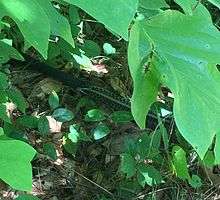Lampropeltis nigra
Lampropeltis nigra, commonly known as the black kingsnake, is a nonvenomous colubrid species indigenous to the United States. It is a species of kingsnake.[1][2]
| Lampropeltis nigra | |
|---|---|
.jpg) | |
| A black kingsnake, Lampropeltis nigra, in captivity. | |
| Scientific classification | |
| Kingdom: | Animalia |
| Phylum: | Chordata |
| Class: | Reptilia |
| Order: | Squamata |
| Suborder: | Serpentes |
| Family: | Colubridae |
| Genus: | Lampropeltis |
| Species: | L. nigra |
| Binomial name | |
| Lampropeltis nigra (Yarrow, 1882) | |
| Synonyms | |
Description
The black kingsnake is a large to medium constrictor. Adult specimens attain an average size of 90 to 122 centimetres (35 to 48 in) in total length, with some reaching maximum total lengths of 147 to 183 centimetres (58 to 72 in).[2][3] It is generally similar to L. getula getula, although its can be distinguished by its geography and appearance. It has a black body that is interspersed with widely spaced yellow or cream-colored speckles, larger and more numerous along the sides. The dorsum in some is unpatterned and in others crossbanded.[2] The venter displays a checked black and yellow (or cream) pattern. Ventral scales range from 197 to 222 in both sexes, with subcaudal scales ranging from 45 to 59 in males and 37 to 51 in females.[1][3]
Geographic range
The black kingsnake is found in the southeastern quarter of the United States, ranging from southern Illinois to Ohio, then down along the foothills of the Appalachian Mountains and the Alabama River watershed to the northern Gulf Coast in south Alabama and along the coast to the Mississippi River in Louisiana.[2][3]
Habitat

Black kingsnakes occupy a wide variety of habitats and is one of the most frequently encountered species by humans in some states. Preferred habitats include abandoned farmsteads, debris piles, edges of floodplains, and thick brush around streams and swamps.[2]
References
| Wikimedia Commons has media related to Lampropeltis nigra. |
- "Pyron, R.A., & F.T. Burbrink. 2009. Systematics of the Common Kingsnake (Lampropeltis getula; Serpentes: Colubridae) and the burden of heritage in taxonomy" (PDF). Zootaxa. Magnolia Press. Archived from the original (PDF) on March 12, 2012. Retrieved September 27, 2012.
- Mount, Robert H. (1975). The Reptiles and Amphibians of Alabama. Auburn, Alabama: Auburn Printing Company. pp. 200–201. OCLC 1958638.
- "Lampropeltis nigra (YARROW, 1882)". The Reptile Database. Zoological Museum Hamburg. Retrieved September 27, 2012.